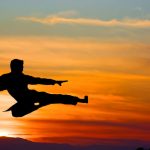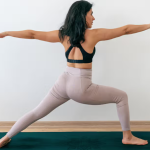In the world of yoga, it’s easy to get stuck in your own yoga bubble. Iyengar Yoga and Ashtanga Yoga are two of the most practised forms of yoga in the world, but there’s plenty of misconceptions out there about what they actually consist of. So let’s go bust some myths!
The Facts
Iyengar Yoga and Ashtanga Yoga are rooted in the same heritage, and were founded respectively by B.K.S. Iyengar and K. Pattabhi Jois. Ashtanga means 8-limbed, and refers to the 8 strands that make up the discipline of yoga. As the name suggests, it is a form of yoga with an ancient heritage, but Jois put his own personal stamp on his form of yoga. Iyengar Yoga is clearly named after the man himself.
Both men were taught by the same guru, the uncompromising Sri Tirumalai Krishnamacharya. This small, learned Indian man never left India, but, through teaching at least two of the most influential yoga masters the world has ever seen, earned his title of the ‘father of modern yoga’.
From the outset, their approaches to yoga were different. Iyengar was Krishnamacharya’s sickly nephew, sent to study under his uncle at 14 years old, as a last ditch attempt to strengthen him after his father died. Jois became one of Krishnamacharya’s first students after witnessing a yoga demonstration, and remained so for almost 30 years, while Iyengar only stayed for a short while, before he left to make his own way.
However, although these two titans of modern yoga studied their craft under Krishnamacharya, their methodologies can seem radically different.
Myth 1 – Ashtanga Yoga is hardcore
One of the misconceptions is that Ashtanga Yoga is only for super-fit, young athletes. Jois partly came up with his sequences as a way of helping young, energetic boys burn off excess energy, so it’s easy to see why people think that.
However, Ashtanga Yoga is for anyone. Beginner students start by learning the sun salutation and are gradually introduced to new postures, but only once they’ve mastered the basic movements of each pose under the guidance of a teacher.
Here’s Pattabhi Jois, saying it best:
“Anyone can practice. Young man can practice. Old man can practice. Very old man can practice. Man who is sick, he can practice. Man who doesn’t have strength can practice. Except lazy people; lazy people can’t practice ashtanga yoga.”
Myth 2 – Iyengar Yoga is gentle
Using his own body as his ‘laboratory’ (as he puts it) Iyengar’s approach was to work out for himself, firstly as a sickly child, and later as a grown man (who had dislocated his spine in a horrendous accident) how to use yoga to heal his body. He began to realise that fast-paced yoga was only possible for younger, fit people and tended towards inaccuracy. So Iyengar began to slow down his practice to explore every aspect of each asana.
This has given rise to the perception of Iyengar Yoga as a ‘gentle’ form of ‘therapy’. However, as an Iyengar Yoga teacher myself, I can personally vouch for the fact that 99% of the time, it is anything BUT gentle.
Due to the focus on alignment and subtle precision in every pose, students need to have the physical and mental stamina to hold the poses for longer than the 5 breaths prescribed in Ashtanga Yoga. As Iyengar himself puts it:
“Endurance is needed to remain in an asana.”
Myth 3 – Ashtanga Yoga is too rigid in its sequencing
It is true that in Ashtanga Yoga the sequences of poses are strictly prescribed. All beginners start with the primary series and progress to the next series if their teacher deems them proficient and ready. There are 6 series, with an average of 25 postures in each one, although only one student is known to have completed the sixth and final series, which is shrouded in mystery. If rumour is to be believed, some of the postures include stopping your own heartbeat and the only person in the world to have even attempted it is Sharath Rangaswamy, the grandson of Pattabhi Jois. Best leave that one to the experts…
The rigidity of this sequencing has caused ruptures within the Ashtanga Yoga world, when, for example, in the 1990s Larry Schultz, the ‘bad man of ashtanga yoga’ set up Rocket Yoga, which incorporated poses from all 3 of the first three sequences – Primary, Intermediate and Advanced A.
However, the set sequence of poses means that students have to face every pose before moving on to the next, whether they like it, or not. By facing the poses they’d rather skip, Ashtanga Yoga acts as a mirror to the student’s own weaknesses, challenging them to face their fears and move on. Which could be seen as the greatest liberation of all.
Myth 4 – Iyengar yoga is not flow yoga
It is also true that Iyengar can be a slower form of yoga. Teachers often demonstrate every pose before students attempt it, and due to the emphasis on alignment in the pose, they are often held for longer. However, this is only within the confines of the yoga lesson.
Real yoga is the yoga we do at home, the lessons are just a preparation. As Iyengar students become more proficient and quicker to incorporate the adjustments of each pose, the sequences can flow from one pose to another.
In fact, in a video of Iyengar, filmed in 1977, he flows through various poses, revealing his mastery and control of asana, body, mind, and breathing.
Myth 5 – Ashtanga and Iyengar are opposing forms of yoga
There are key differences between the two yogic practices. In Ashtanga Yoga, the importance of the breath cannot be overempasized, as the breath is the key to the poses. The term ‘Vinyasa’ (or ‘flow’ yoga) means ‘breath synchronised movement’, and according to Jois, ‘Breath is life’. In Iyengar Yoga, the breath is important too, and Iyengar has written a whole book on pranayama, the control of the breath. But there is less emphasis on the breath while practising the asanas themselves. And we’ve already looked into flow vs static, hardcore vs gentle and so on.
But appearances can be deceiving. Although Iyengar Yoga and Ashtanga Yoga have their differences, the guiding philosophy of both men was the same. Both masters devoted their lives to their art and gave this knowledge freely to those of us that follow after them. Both forms of yoga access the mental, emotional and spiritual realms through the doorway of our physical bodies. And, as such, they both exhort students to practice, as much as they can:
“Practice and all is coming” said Jois, “Persistent practice alone is the key to yoga” said Iyengar, in agreement.
We have so much to learn from each other in the world of yoga. Let’s not point out the differences, but celebrate what makes us the same – joined and united in the love of yoga.













